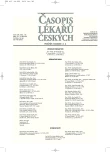-
Medical journals
- Career
Practical Aspects and Clinical Value of t(14;18) Monitoring in Peripheral Blood of the Follicular Lymphoma Patients
Authors: A. Janíkováobořilová 1; J. Mayer 1; D. Dvořáková 1; P. Mejstřík 1; M. Navrátil 1; I. Vášová 1; L. Křen 2; M. Matuška 3
Authors‘ workplace: Interní hematoonkologická klinika FN, Brno 1; Patologicko–anatomický ústav FN, Brno 2; Onkologické oddělení FN, Ostrava 3
Published in: Čas. Lék. čes. 2007; 146: 374-381
Category: Original Article
Overview
Background.
Evaluation of practical value of monitoring t(14;18) in peripheral blood in follicular lymphoma.Methods and Results. t(14;18) was tested in 115 follicular lymphoma patients by methods:
FISH, nested and multiplex PCR of blood, bone marrow and lymph node specimens. We tested the patients with rearrangement MBR quantitatively by real-time PCR. Testing intervals of t(14;18) in peripheral blood were 1 month during treatment, 2–3 months during the first year after the end of treatment, then every 4 to 6 months. Patients were clinically examined in the same intervals and regular restaging was done by CT/PET. Each patient was evaluatee separately. Total detection of t(14;18) was 97 % regardless tissue and methods of detection, FISH was superior to PCR (95 % vs 72 %). The higher number of copies were observed in lymph nodes in comparison to bone marrow (p=0,036) and peripheral blood (p=0,016); 46/115 (40 %) patients were positive for MBR, we followed up behaviour of t(14;18) in peripheral blood in 33 of them in long intervals (>6 months, med. 33 months). Molecular and clinical courses correlated in 20/33 (61 %) patients, 7/33 (21 %) clinically relapsed in lasting molecular remission. We found very short interval to clinical relaps in 7 cases of molecular relapses (0–5 months, median 3 months). We could not define “threshold quantity” of clinically important molecular relaps. Lasting molecular remission was associated with clinical in about 60 % cases; lasting molecular activity corresponded with clinical relaps in 86 % patients.Conclusions.
t(14;18) is highly associated with follicular lymphoma. In practice, monitoring of t(14;18) is feasible only in part of patients. Even if there is some correlation of clinical and molecular course, monitoring of t(14;18) in blood bears only limited prognostic value for the concrete patient. The treatment of patient can not be accomplished on the basis of these results only.Key words:
follicullar lymphoma, t(14;18), bcl-2/IgH.
Labels
Addictology Allergology and clinical immunology Angiology Audiology Clinical biochemistry Dermatology & STDs Paediatric gastroenterology Paediatric surgery Paediatric cardiology Paediatric neurology Paediatric ENT Paediatric psychiatry Paediatric rheumatology Diabetology Pharmacy Vascular surgery Pain management Dental Hygienist
Article was published inJournal of Czech Physicians

-
All articles in this issue
- Decompressive Craniectomy in the Treatment of Posttraumatic Edema and the Contribution of new Diagnostic Methods
- Milestones of Cardiovascular Pharmacotherapy: II. Digitalis
- Perioperative Betablockade
- Adjuvant Chemotherapy in the Treatment of Non-small Cell Lung Cancer
- Phytosterols as a Functional Food
- Genotype – Disease Association and Possibility to Reveal Environmentally Modifiable Disease Causes: The Use of Mendelian Randomization Principle
- How to Continue in the Treatment of Tuberculosis in the Czech Republic?
- Factors Modulating Parameters of Cholesterol Homeostasis in the Metabolic Syndrome
- Relation Between Alcohol Intake and Some Metabolic and Cardiovascular Risk Factors in the Healthy Men
- Practical Aspects and Clinical Value of t(14;18) Monitoring in Peripheral Blood of the Follicular Lymphoma Patients
- Effect of Surgical Treatment of Atrial Fibrillation on the Attainment and Maintenance of Sinus Rhythm in Patients Undergoing Concomitant Cardiac Surgery – Short-term Results
- The Use of Thrombelastography in Evaluation of Coagulation in Females with Physiological or Pathological Gravidity
- The Use of Paracetamol in Children –Benefits and Risks
- Indication to Occlusion of Patent Foramen Ovale in Patient with Pulmonary Hypertension after a Cardioembolic Stroke
- Journal of Czech Physicians
- Journal archive
- Current issue
- Online only
- About the journal
Most read in this issue- Adjuvant Chemotherapy in the Treatment of Non-small Cell Lung Cancer
- Indication to Occlusion of Patent Foramen Ovale in Patient with Pulmonary Hypertension after a Cardioembolic Stroke
- Phytosterols as a Functional Food
- The Use of Paracetamol in Children –Benefits and Risks
Login#ADS_BOTTOM_SCRIPTS#Forgotten passwordEnter the email address that you registered with. We will send you instructions on how to set a new password.
- Career

